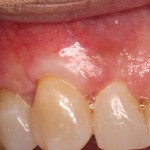Receding Gums
Causes
Receding gums are due to anatomic, mechanical, gingival inflammation, and periodontitis. This common problem can cause esthetic problems, root caries, sensitivity to hot and cold, and excessive wearing of the root surface. Generally, there are two types of recession that are commonly seen clinically. Recession caused by gum disease or periodontitis is seen on all surfaces of the teeth and is irreversible. In contrast, facial receding gums caused by mechanical factors is reversible. Facial recession is commonly associated with patients with high personal and professional dental care. Recession associated with periodontitis is commonly associated with patients with poor oral hygiene and large amounts of plaque and calculus.
Prevalence
Studies confirm that receding gums increases with age and a substantial increase for each decade of life. 90% of Americans by age 60 have at least one site with ≥1 mm of recession, while about 40% have at least one site with ≥3 mm of recession. Sites with recession are likely to progress. Untreated recession sites in patients not receiving regular dental care are more likely to progress than sites treated with a gingival augmentation procedure. Since additional gingival recession increases attachment loss, appropriate treatment is indicated at progressing sites to prevent additional loss, to improve function, and provide a normal appearance.
Treatment
Periodontal plastic surgery has been proposed to describe a mucogingival surgical procedure designed to correct defects in morphology, position, and dimensions of the gingiva surrounding teeth for esthetic purposes. There are many techniques that have been deemed as periodontal plastic surgery. These include laterally positioned flap, free gingival graft, connective tissue graft, coronally positioned flap, guided tissue regeneration, and acellular dermal matrix. The use of acellular dermal matrix (ADM) as a substitute for connective tissue is a relatively new approach that allows coverage of multiple sites and does not require autogenous donor tissue. The ability to cover an unlimited number of sites without the need for a second surgical site to obtain donor tissue is a significant advantage for this material. A acellular dermal matrix (Perioderm) was utilized in the current case. The patient experienced minimal pain and was extremely happy with the outcome.
I’m extremely excited to perform this procedure for many of my patients with excellent results.





 by
by 


